
Warm hints: The word in this article is about 3250 words and the reading time is about 18 minutes.
Introduction
This paper shows the comprehensive introduction of resistor which is one of the common electronic components . Resistance is the ability to impede the flow of electrons, that is, the value of resistance, the unit is "Ω". A resistor is a device that has a certain resistance to current flow. The resistor is usually referred to as a resistor . The resistor is mainly responsible for the current limiting shunt in the circuit, and can also form other functions with other components, such as the wave-out circuit, etc. Commonly used resistors are mainly divided into three main parts: ordinary resistors (resistance fixed), variable resistors (resistors can be continuously variable or fine-tuning), sensitive resistors (including special functions, such as a photosensitive resistor, thermistor, etc.).
How to Read Resistor Color Codes Fast
I What is resistor
Resistance is one of the most common and widely used components in the electronics industry. Its English name is called Resistor, which is often used to express R. Its unit is Ohm, which is represented by the symbol "Ω". In physics, the resistance indicates the size of the conductor to obstruct the current. The greater the resistance, the greater the hindrance to the current. A resistance element is an energy dissipation element that presents a hindrance to the current.
II The size of the resistor
Electrical resistance of an electrical conductor depends on
-
> the length of the conductor
-
> the material of the conductor
-
> the temperature of the material
-
> the cross-sectional area of the conductor
and can be expressed as
R = ρ l / A
where
R = resistance of the conductor (ohms, Ω)
ρ = resistivity of the conductor material (ohm meter, Ω m)
l = length of conductor (m)
A = cross-sectional area of conductor (m2)
Usually, when a constant resistance is made, its resistance is determined. The calculation formula of resistance is: R=U/I. That's Ohm's law.
Example:
The resistance of 10 meter gauge 17 copper wire with cross sectional area 1.04 mm2 can be calculated as
R = (1.7 x 10-8 Ω m) (10 m) / ((1.04 mm2)(10-6 m2/mm2))
= 0.16 Ω
168a
III Classification of resistors
There are different types of resistance . The material has a carbon carbon-film -and-metal-film-resistors>carbon-film -and-metal-film-resistors> film resistor , metal film resistor, cement resistor , Wirewound resistors; according to the function can be divided into thermistors, varistors, photosensitive resistance; according to power, 1/16W, 1/8W, W W 1W, integrant, etc. According to the accuracy, it can be divided into 0.1%, 1%, and 5%. When a temperature sensor is designed, a thermistor that is sensitive to temperature can be used to build the temperature of the circuit detection environment.
IV Uses of resistors
The main functions of the resistor in the circuit are shunt, current limiting, partial pressure, filter (combined with capacitor use) and impedance matching.
Shunt effect: two resistors in parallel together as two branches, will be the current road diversion, as shown below.
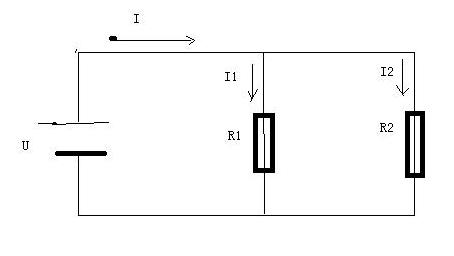
two resistors in parallel together as two branches
The current is I = I1 I2.
Current limiting function: resistor series can limit the size of branch current in the circuit, and prevent the load in the circuit from burning out.
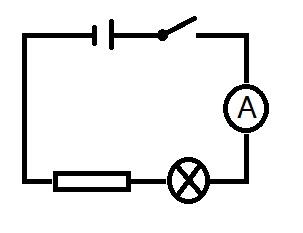
Current limiting function
Partial pressure function: after two series resistors are connected in series, the current flowing through two resistances is equal, but the voltage of each resistor is not equal, which is obtained by Ohm's law. As shown in the following figure.
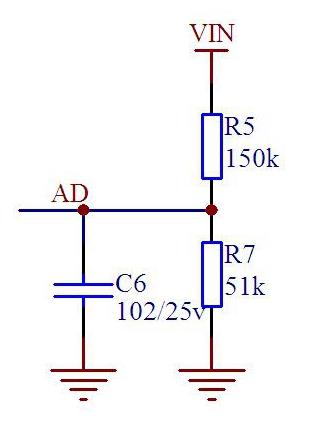
Current limiting function
Filter function: used in conjunction with the capacitor can be constructed as a filter, as shown in the following figure.
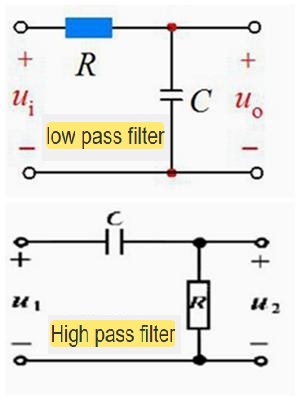
Filter function
V Series and parallel resistors
The series and parallel resistors are the lessons learned in the middle school textbooks, and their typical circuit diagrams are shown below.
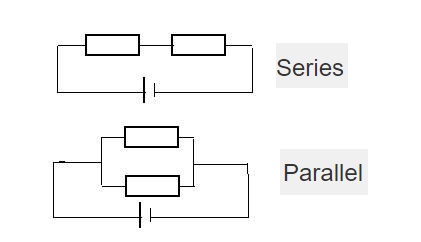
series and parallel resistor
> Series: the resistance after series is equal to the sum of the resistors.
> Parallel: the reciprocal of the total resistance after the parallel is equal to the sum of the reciprocals of the resistors.
VI Resistor Color Code
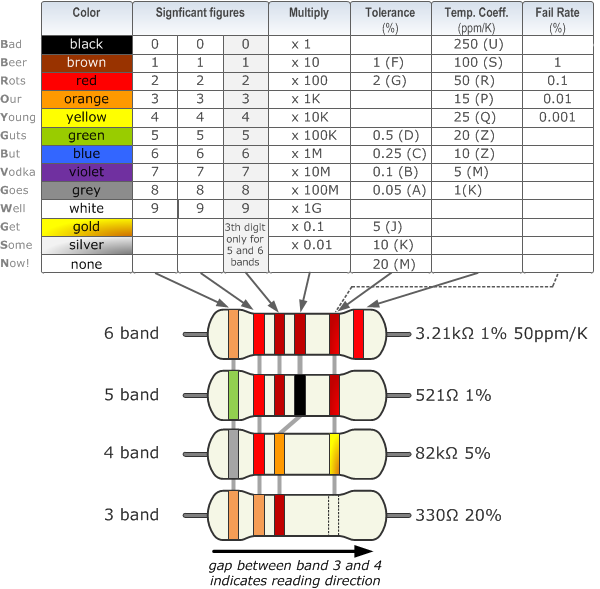
Resistor Color Code
Resistor values are often indicated with color codes. The color ring resistors indicate the parameters of the resistance according to the different colors of the surface. 4 and 5 color resistors are commonly used. The 4 color ring resistor is usually a carbon film resistor . It uses the front 3 color rings to indicate the resistance. Fourth points are used to indicate the error. The 5 color ring resistance is usually a metal film resistor , the 5 color ring ratio is 4 color ring, and the accuracy is higher. The 4 color indicates the resistance value, fifth representations. The color code is given by several bands. Together they specify the resistance value, the tolerance and sometimes the reliability or failure rate. The number of bands varies from three to six. As a minimum, two bands indicate the resistance value and one band serves as a multiplier. The resistance values are standardized, these values are called preferred values.
6.1 4 band resistor
The four-band color code is the most common variation. These resistors have two bands for the resistance value, one multiplier and one tolerance band. In the example on the left, these bands are green, blue, red and gold. By using the color code chart, one finds that green stands for 5 and blue for 6. The value is thus 56·100 =5600 Ω. The golden band means that the resistor has a tolerance of 5%. The resistance value lies therefore between 5320 and 5880 Ω. If the tolerance band would be left blank, the result is a 3 band resistor. This means that the resistance value remains the same, but the tolerance is 20%.
|
Color |
First Ring |
Second Ring |
Multiplier |
Fair rate |
|
Black |
0 |
0 |
10^0 |
——— |
|
Brown |
1 |
1 |
10^1 |
——— |
|
Red |
2 |
2 |
10^2 |
——— |
|
Orange |
3 |
3 |
10^3 |
——— |
|
Yellow |
4 |
4 |
10^4 |
——— |
|
Green |
5 |
5 |
10^5 |
——— |
|
Blue |
6 |
6 |
10^6 |
——— |
|
Purple |
7 |
7 |
10^7 |
——— |
|
Gray |
8 |
8 |
10^8 |
——— |
|
White |
9 |
9 |
10^9 |
——— |
|
Gold |
——— |
———— |
10^-1 |
±5% |
|
Silver |
——— |
———— |
10^-2 |
±10% |
6.2 5 band resistor
Resistors with high precision have an extra band to indicate a third significant digit. Therefore, the first three bands indicate the significant digits, the fourth band is the multiplying factor and the fifth band represents the tolerance. There are exceptions to this. For example, sometimes the extra band indicates failure rate (military specification) or temperature coefficient (older or specialized resistors).
| Color | First Ring | Second | Third Ring | Multiplier | Fair rate |
|
Black |
0 |
0 |
0 |
10^0 |
—— |
|
Brown |
1 |
1 |
1 |
10^1 |
1% |
|
Red |
2 |
2 |
2 |
10^2 |
2% |
|
Orange |
3 |
3 |
3 |
10^3 |
—— |
|
Yellow |
4 |
4 |
4 |
10^4 |
—— |
|
Green |
5 |
5 |
5 |
10^5 |
0.5% |
|
Blue |
6 |
6 |
6 |
10^6 |
0.25% |
|
Purple |
7 |
7 |
7 |
10^7 |
0.1% |
|
Gray |
8 |
8 |
8 |
10^8 |
±20% |
|
White |
9 |
9 |
9 |
10^9 |
—— |
|
Gold |
—— |
—— |
—— |
10^-1 |
±5% |
|
Silver |
—— |
—— |
—— |
10^-2 |
±10% |
6.3 6 band resistor
Resistors with 6 bands are usually for high precision resistors that have an additional band to specify the temperature coefficient (ppm/K). The most common color for the sixth band is brown (100 ppm/K). This means that for a temperature change of 10 ˚C, the resistance value can change by 0.1%. For special applications where temperature coefficient is critical other colors
6.4 Color code exceptions
> Single black band or zero-ohm resistor. A resistor with a single black band is called a zero-ohm resistor. Principally it is a wire link with the only the function of connecting traces on a PCB. Using the resistor package has the advantage of being able to use the same automated machines to place components on a circuit board.
> Reliability band. Resistors that are produced according to military specifications, sometimes include an extra band to indicate reliability. This is specified in the failure rate (%) per 1000 hours of service. This is rarely used in commercial electronics. Mostly the reliability band can be found on four > Band resistors. More information about reliability can be found in the US military handbook MIL-HDBK-199.
Deviating colors. For high voltage resistors often the colors gold and silver are replaced with yellow and gray. This is to prevent having metal particles in the coating.
> 5 band resistor with the 4th band of gold or silver. Five band resistors with the fourth band of gold or silver form an exception and are used on specialized and older resistors. The first two bands represent the significant digits, the 3th the multiplying factor, the 4th the tolerance and the 5th the temperature coefficient (ppm/K).
VII Types of resistor
- SMD resistor

SMD resistor
SMD resistors have the advantages of small volume, lightweight, high installation density, strong seismic resistance, strong anti-interference ability and high-frequency characteristics. They are widely used in computers, mobile phones, electronic dictionaries, medical electronic products, video cameras, electronic watt-hour meters and VCD machines. The patch components can be divided into three types, which are rectangular, cylindrical and heteromorphic according to their shape. There are resistors, capacitors, inductors, transistors and small integrated circuits. The patch elements are different from those of the general components.
- Cement resistor
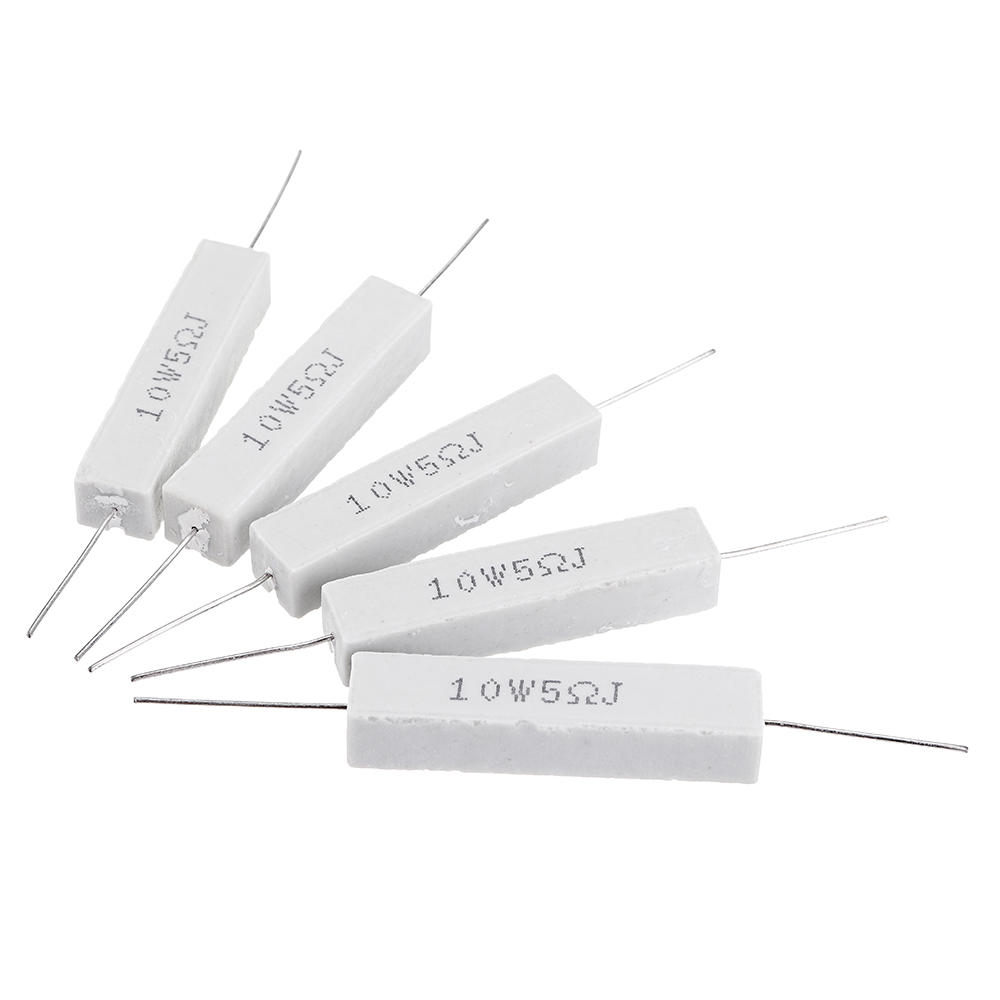
Cement resistors
Cement resistance is a kind of rake resistance, usually put resistance into the square porcelain, with special non-flammable and heat-resistant cement filling and sealing, and the outer image is a cement block, so it is called cement resistor. Cement resistor with high power heat stability high moisture resistant seismic characteristics. It is mainly used in high power circuits, such as the overdetection and protection circuit of the power circuit, and the power output circuit in the audio amplifier is medium. The cement parameter is the direct standard method.
- Array Resistor
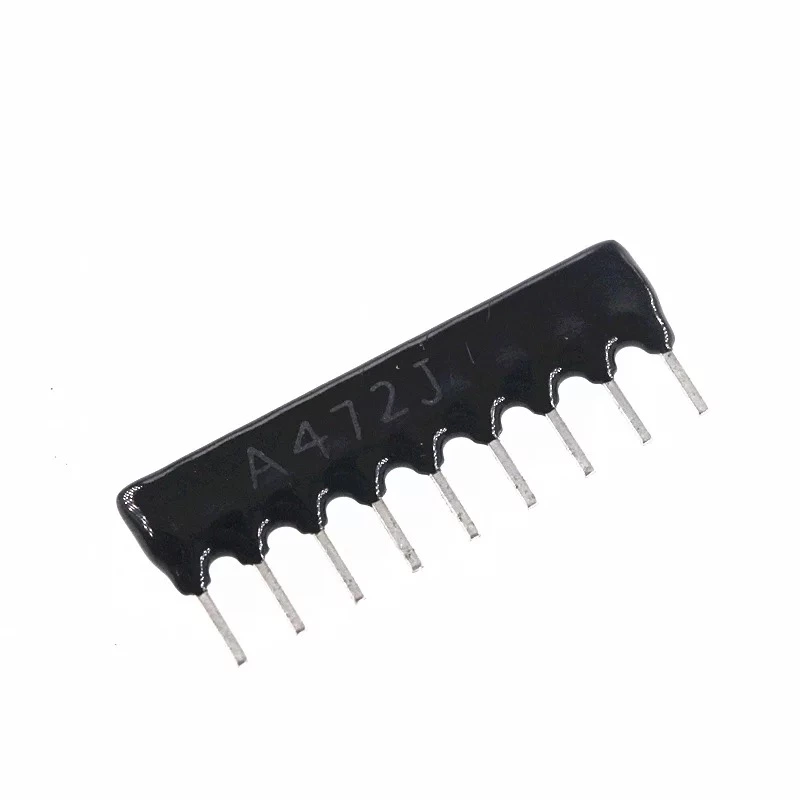
Array resistor
The network resistor which is also called Wire-wound Resistor is a combination of several resistors that are exactly the same. One of their pins is connected together as a common pin. The rest of the pins are normally elicited. So if a drag is made up of a resistor, then it has an n 1 pin. Generally, the one on the left is a common pin. It is usually marked with a color point on the drag. It has many advantages, such as convenient assembly and high density. It has been widely used in TV, display, computer mainboard and small household appliances. Network resistor usually has a public side, with a white spot on the surface of said package. The color is usually black or yellow. The network resistor is generally applied to digital circuits, such as: as a pull or pull-down resistance of a parallel port. The use of the network resistor ratio is more convenient to use a number of fixed resistors . It is directional and has the advantage of neatly and less space than the color ring resistance.
-
Wirewound Resistors
Wirewound resistors are made by wrapping a high resistance wire, generally a nickel-chromium alloy, around a ceramic bobbin. By varying the diameter, length, and alloy of the wire and the wrap pattern the properties of the wire-wound resistor can be tailored to the application. They do suffer from high inductance and capacitance due to the nature of their construction, which limits them to low-frequency applications.
-
Metal Film Resistors
As one of the popular resistor types , metal film resistors are similar in construction to carbon film resistors , with the main difference being the use of a metal alloy as the resistive material rather than carbon. Metal film resistors are low noise, and stable with little resistance change due to temperature and applied voltage.
-
Carbon Composition Resistors
Carbon composition resistors use a solid block of material made from carbon powder, an insulating ceramic, and a binder material. The resistance is controlled by varying the ratio of carbon to the filler materials. The carbon composition in the resistor is affected by environmental conditions, especially humidity, and tends to change in resistance over time. Carbon composition resistors have a poor resistance tolerance, however, they have a good frequency response making them an option for high-frequency applications.
-
Carbon Film Resistors
Carbon film resistors use a thin layer of carbon on top of an insulating rod which is cut to form a narrow, long resistive path. The capabilities of a carbon film resistor are better than a carbon composition resistor , with power ratings up to 5 watts and better stability. However, their frequency response is much worse due to the inductance and capacitance caused by the resistive path cut into the film.
-
Thin Film Resistors
Borrowing from semiconductor processes, thin-film resistors are made through a vacuum deposition process called sputtering where a thin layer of conductive material is deposited on an insulating substrate. This thin layer is then photo-etched to create a resistive pattern. By precisely controlling the amount of material deposited and the resistive pattern, tolerances as tight as 0.01% can be achieved with thin-film resistors. Thin-film resistors are limited to about 2.5 watts and lower voltages than other resistor types but are very stable resistors.
-
Thick Film Resistors
Thick Film Resistors are made in a screen printing process using a conductive ceramic and glass mixture composite suspended in a liquid. Once the resistor has been screen printed, it is baked at high temperatures to remove the liquid and fuse the ceramic and glass composite. They have a high-temperature coefficient, with a 100°C temperature change resulting in up to a 2.5% change in resistance.
VIII The function of resistor
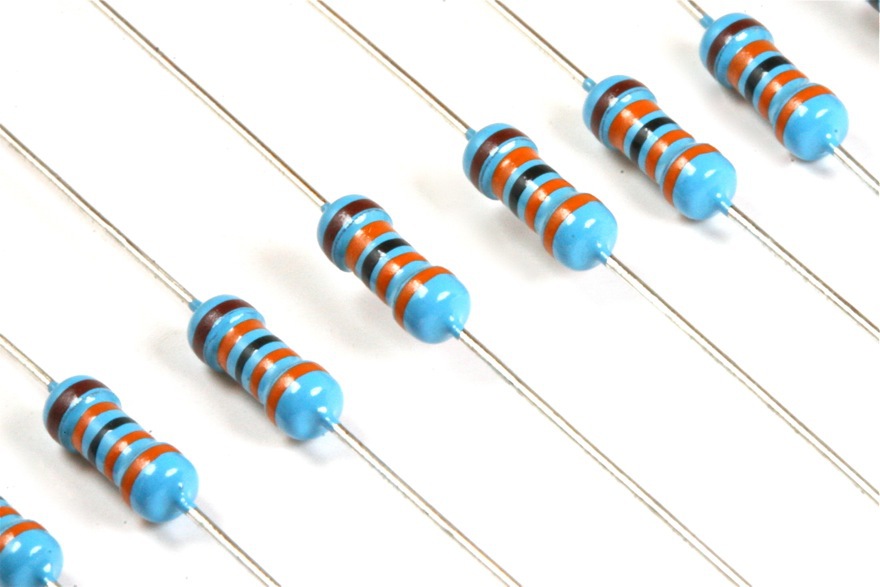
resistor
If the resistance of a resistor is close to zero ohms (for example, a large cross-section conductor between two points), the resistor has no impediment to the current. The circuit of the parallel resistor is short-circuited, and the current is infinite. If a resistor has infinite or large resistance, the loop of the resistor can be regarded as an open circuit and the current is zero.
The resistor commonly used in industry is between two extreme cases. It has a certain resistance. It can pass a certain current, but the current is not as large as that when it is short-circuited. The current limiting effect of a resistor is similar to the effect of a small diameter tube connected to two large-diameter tubes to limit the flow of water.
Resistance, the English name resistance, usually abbreviated to R, is a basic character of a conductor, which is related to the size, material and temperature of the conductor. Ohm's law says, I=U/R, then R=U/I, the basic unit of resistance is Ohm. With the Greek letter "Ω", there is such a definition: when a volt voltage is added to the conductor, a resistance value corresponding to an ampere current is generated. The main function of the resistance is to impede the flow of the current.
In fact, the resistance is natural, and the resistance usually referred to in the electronic product refers to a resistor such as a resistor. Ohm is often referred to as Europe. The commonly used units to represent resistance values are thousands of Europe (kΩ), mega (MΩ), and m Ω.





